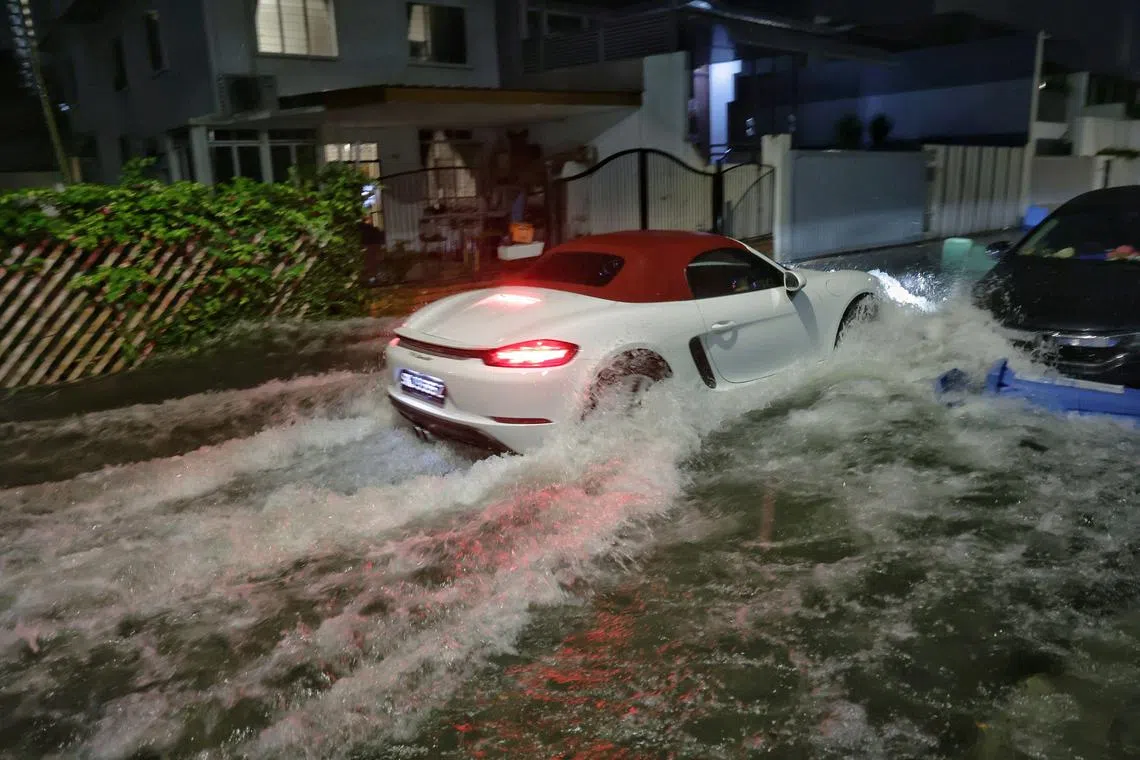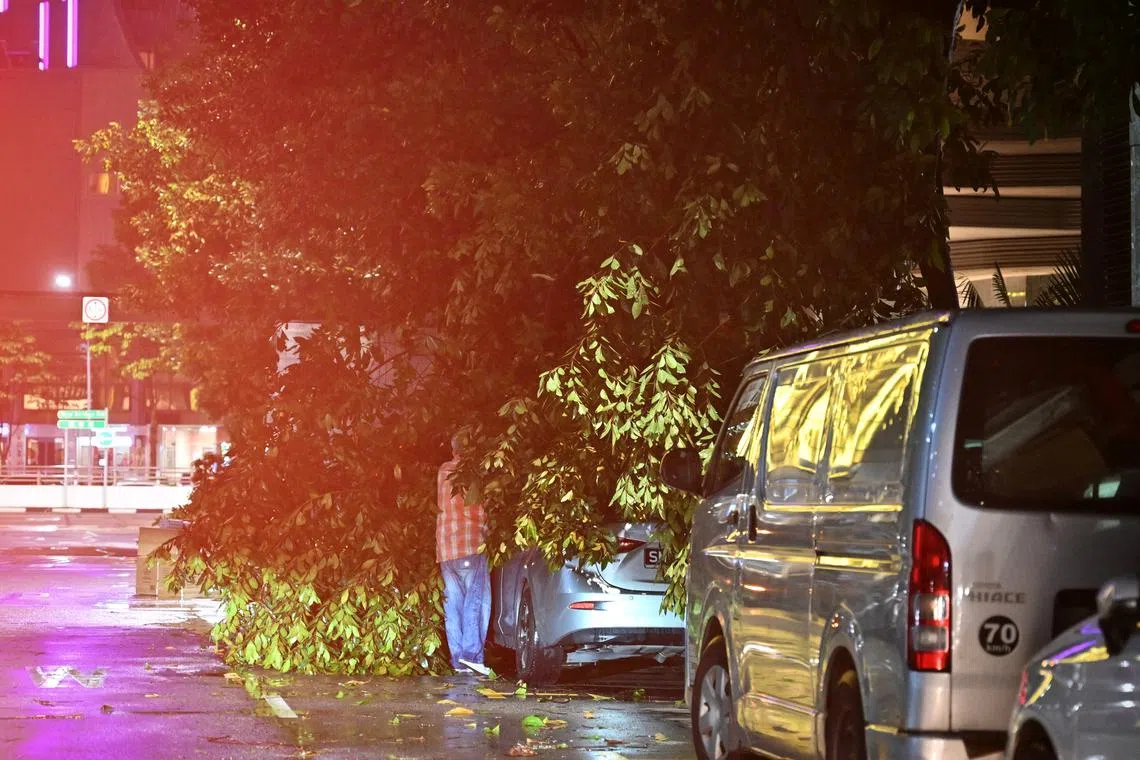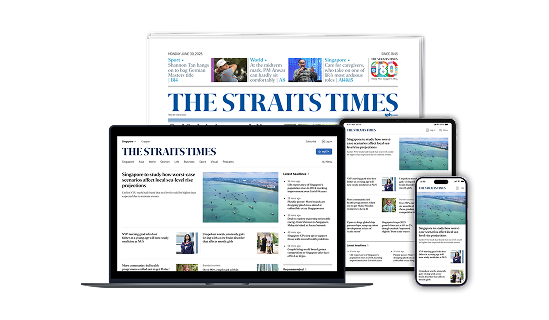askST: How can motorists stay safe on the road during a monsoon surge?
Sign up now: Get ST's newsletters delivered to your inbox

PUB said motorists should avoid going behind the wheel once water levels are as high as road kerbs, or when road markings are no longer visible.
ST PHOTO: KEVIN LIM
Follow topic:
SINGAPORE - A second monsoon surge was expected to hit Singapore from Jan 17 to 19,
The Jan 10 to 13 surge saw flash floods, falling trees and temperatures plunging to 21.6 deg C in Newton.
The Straits Times spoke to experts to find out how motorists can navigate roads safely during flooding.
Q: Should you try and drive through a flash flood?
A: Experts advise motorists, both drivers and motorcyclists, to stay off the roads when there are flash floods due to safety reasons.
National water agency PUB said in an advisory that motorists should avoid going behind the wheel once water levels are as high as road kerbs, or when road markings are no longer visible.
Kerb-level flood water is a sign of significant water congestion which is likely to rise further, said Mr Jackson Lin, owner of car workshop TT Motorsport. “At this point, it’s best to avoid taking the risk of driving through.”
Seeping waters may damage the electrical system of a vehicle and cause it to malfunction, potentially resulting in a loss of control in braking and steering, he added.
Mr Gilbert Ng, director of car workshop Accord Auto Services, said car engines may be hydrolocked – which happens when liquid enters the cylinder of an engine – and stalling may occur.
Restarting an engine when it is hydrolocked may result in critical parts of the engine being severely damaged, he added.
Driving or riding through flood waters will likely lead to aquaplaning, said Singapore Road Safety Council chairman Bernard Tay. Aquaplaning occurs when the car tyres ride on a thin layer of water and lose contact with the road.
He advised motorists to take public transport instead. “The wheels of the buses are much higher so they can go through floods more easily.”
Q: What should you do if it starts flooding when you are on the road?
A: PUB said vehicles should stay close to the middle lane as water tends to accumulate on the sides.
It told drivers to not try and restart their vehicle if it stalls. Instead, turn on the hazard lights, call for assistance and move to higher ground.
Drivers should maintain a steady acceleration and avoid sudden starts or stops to reduce chances of the car engine stalling, said Mr Ng. If it stalls, do not restart the car and tow it to a mechanic instead, he added.
Mr Tay said drivers should maintain a considerable distance from the car ahead, as vehicles may not brake as quickly in wet conditions.
“In good driving conditions, most people use a three-second rule to react and respond to a situation safely and avoid a crash. However, during heavy rain, motorists may need to increase the timing,” he said.
“A lot of vehicles drive close to each other during bad weather because of jams. This is not advisable as one crash may lead to a chain collision,” he added.
Q: What are some safety measures you can take before driving in bad weather?
A: If there is impending rain, motorists should check that their car tyres are in good condition before hitting the road, said experts.
Drivers should ensure that their windshield wipers are working, so they have clear visibility, said Mr Tay.
They should refrain from parking their vehicles on the ground level to prevent their cars from being submerged, he added.
Mr Hakim Zainol Abidin, owner of motorcycle workshop Bear’s Garage, said motorcyclists should make sure they are wearing proper weatherproof riding gear, which includes a raincoat, gloves and proper footwear.
All lights on the motorcycle should be in working condition and riders should wear high-visibility clothes, he added.
PUB urged all motorists to update themselves by following its flood alert channel and plan their routes accordingly.
Q: Are some vehicles more prone to damage during floods than others?
A: Larger vehicles like sport utility vehicles and trucks, especially those with higher ground clearance and 4WD capabilities, are generally safer in floods, said Mr Teng Dao Xiong, managing director of 1 Car Service Workshop.
Smaller sedans are more prone to damage and slippage due to their low ground clearance and lighter weight, he added.
“Electric vehicles and hybrids may also be more vulnerable due to their extensive electronic systems,” he said.
Q: Can insurance claims be made for damage caused by flooding or bad weather?
A: Fixing damage caused by flood waters to a vehicle can be costly, said Mr Ng, who added that replacing a faulty engine control unit can be “prohibitively expensive”.
And insurance companies said that not all car insurance policies cover vehicle damage caused by floods.
For example, Etiqa Insurance Singapore’s comprehensive motor insurance plan covers damage inflicted by weather conditions such as floods, but its third party or theft coverage plans do not.
The most common weather-related claims made by motorists in Singapore mainly include damage caused by flooding, wind or debris, lightning strikes or collapsed structures and trees, said Etiqa’s chief executive Raymond Ong.
He said motorists should ensure they are adequately protected against these potential risks and take necessary precautions.
“In Singapore, where unpredictable weather conditions like heavy rainfall, storms and occasional floods are common, it is essential for vehicle owners to carefully consider the coverage they need,” he said.

The most common weather-related claims made by motorists in Singapore include damage caused by collapsed trees.
ST PHOTO: ARIFFIN JAMAR
Q: How do public buses navigate flash floods?
A: In cases of severe flooding, bus operators SBS Transit and Go Ahead told ST that their drivers will stop the buses and contact their respective operations control centres for advice.
SBS Transit’s control centre will guide bus captains to alternative routes if original routes are impassable due to flooding, said spokeswoman Grace Wu.
Bus drivers will advise passengers against alighting at flooded bus stops for their safety, she added.
Passengers can keep themselves informed of route diversions or skipped bus stops through SBS Transit’s X account, mobile apps and digital screens at bus interchanges.
Go Ahead will also guide its bus captains from its control centre on whether roads are passable, said its spokesperson.
“In situations where flooding is severe, bus captains are advised to stop the bus at a safe location,” said Go Ahead.
“If the flooding is minor, they may proceed slowly with extra caution.
“In the event that a bus stop is affected by flooding, bus captains will inform commuters that the stop will be skipped to ensure their safety.”
Q: How can pedestrians stay safe?
A: Those who come across flooded areas should turn back and move to higher ground as flood levels may rise suddenly, said PUB.
Pedestrians should avoid walking through water that is above ankle height and walk where the water is not moving.
They are also advised to use a stick or an umbrella to check for open drains and the firmness of the ground.
Kolette Lim is a journalist at The Straits Times, covering breaking news and trending topics.


